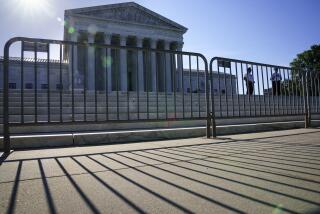Rehnquist’s Mixed Legacy
- Share via
Sixteen men have served as chief justice of the U.S. Supreme Court. Some, like Melville W. Fuller, who presided from 1888 to 1910, inhabit the shadows of the court’s history. Others, possessed of deeply held views and blessed with longevity or a favorable political wind at their backs, have touched Americans more profoundly than many presidents.
The fourth chief, John Marshall, was the first to leave his mark. It will surprise many people to learn that nothing in the Constitution explicitly authorizes the Supreme Court to decide whether acts of Congress are constitutional. In Marbury vs. Madison, Marshall deduced this power from the structure of government that the Constitution created -- and thus he created the institution of judicial review. More than a century later, Chief Justice Earl Warren led his colleagues to apply constitutional principles to outlaw racial segregation and to expand the rights of criminal defendants. Racial equality and the right to a lawyer may seem like obvious constitutional principles today; they didn’t before Warren.
When William H. Rehnquist joined the Supreme Court in 1972, he had ambitions that were similar in size but different in substance. Did he succeed? After 33 years on the court, the last 19 as its leader, Rehnquist’s record is mixed. The Rehnquist court has slowed the expansion of civil rights but has not reversed it in most areas.
*
A Victim of Cancer
The chief justice has cancer and is mostly working from home. This comes after years of rumors that back troubles would force his resignation. The cancer diagnosis last fall intensified predictions of his impending retirement and sparked new discussions of his legacy and the court’s future direction.
Rehnquist found his politics early, in dinner-table discussions with his Milwaukee parents and, after Pearl Harbor, as a neighborhood block captain responsible for reporting “subversive activities” to the police. His interest in history, forged in high school reenactments of the nation’s founding, has endured in his writings, on the bench and off.
In those writings, Rehnquist will often hearken back to the period after the Civil War. Many think of the Reconstruction era as one of brutal repression of minorities and a pinched view of the federal government. Rehnquist, however, finds his legal and ideological touchstones in those years: states’ rights, a narrow view of congressional authority and a bone-deep skepticism about the notion that law should protect private behavior. As a Supreme Court clerk, Rehnquist wrote memos urging his boss, Justice Robert H. Jackson, to dissent in voting-rights and school desegregation cases. Young Rehnquist scornfully dismissed pleas from criminal defendants. When Rehnquist became a justice himself, he took his own advice.
Rehnquist has been least successful in the realm of private behavior. The abortion rights decision, Roe vs. Wade, came a year after he joined the court, and the core of that decision stands three decades later, despite Rehnquist’s fierce opposition. The constitutional ban on school prayer also remains. Rehnquist’s years saw the court uphold laws forbidding consensual sex among homosexuals and, over his objection, then saw the court reverse itself.
He has had his successes. Rehnquist pushed the court to narrow or reverse many protections the Warren court had declared for criminal suspects, prisoners, racial minorities and students, boosting the authority of police, prosecutors, prison wardens and school officials. He and his colleagues struck down New Deal-era federal laws on the grounds that even the commerce clause of the Constitution -- formerly an all-purpose authority for the use of federal power -- did not authorize them. The Rehnquist court struck down laws concerning gun control, sexual assaults and cigarettes on this basis.
*
States’ Rights Booster
The sovereign authority of the states, by contrast, got a boost from Rehnquist. States are now largely free to execute murderers, destroy some inland wetlands and ponds, demote state employees who develop breast cancer or lock up some petty thieves for life, as California has chosen to do.
The stopwatch efficiency that has earned Rehnquist high marks as the court’s manager is also evident in his often-sparse opinions. Here it has not served him or the court as well. Instead of articulating principles that can guide judges and lawmakers, Rehnquist has often focused on the facts at hand. Your guess is as good as a constitutional scholar’s about how the court will rule on any given affirmative-action program. Why some terrorism suspects are entitled to legally challenge their confinement and others are not is similarly mysterious.
Rehnquist’s most memorable accomplishment will probably be his most ignominious, and one of the most “activist” rulings in the court’s history: essentially installing George W. Bush as president in the fatuously reasoned Bush vs. Gore. In the years before 2000, the Rehnquist court had rejected equal-protection claims from death row inmates complaining of racial bias, California homeowners challenging wide disparities in the property tax, gays and lesbians who wanted to serve in the military, and so on. But the same justices found that George W. Bush was a victim of an injustice worthy of the court’s intervention.
The selection of Rehnquist’s successor, whenever it happens, will be a high-stakes battle. Both sides believe that important precedents, Roe among them, now hang on one vote. Rehnquist’s replacement with another conservative may not much change the court’s balance, but with eight of the nine justices over 65, the next vacancy could occur soon, allowing Bush to shift the court sharply right and finish the job Rehnquist started.
More to Read
Sign up for Essential California
The most important California stories and recommendations in your inbox every morning.
You may occasionally receive promotional content from the Los Angeles Times.










